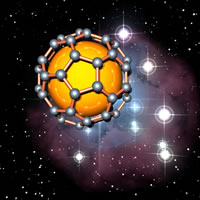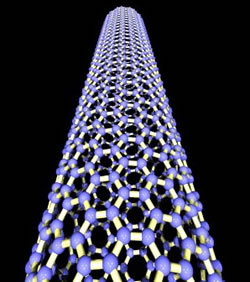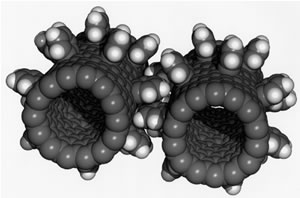Like many people of my generation, I grew up with a healthy fear of the actor, Donald Pleasence. Here was a man capable of portraying evil with unbridled, lolly-pop stealing glee.  In one of his best films, Fantastic Voyage, he and a (ahem) small team of experts are shrunk to microscopic size.
In one of his best films, Fantastic Voyage, he and a (ahem) small team of experts are shrunk to microscopic size.
Why? To save world peace, that's why! The one man who can revolutionise miniaturisation technology has been the victim of an assassination attempt. He has a blood clot in his brain and the only way to save him and the world is to get our team of heroes into his body, to the root of the problem. In Fantastic Voyage, the human body becomes a universe of trials and dangers that our team must survive to save their host.
What this story deals with in its Hollywood fashion is the blossoming field of nanomedicine, a specialised region of the world of nanotechnology. But what exactly is nanotechnology, where is it taking us, and what does it have to do with life saving medicine?
The prefix, nano, originally comes from the Greek word for dwarf, nanos, but today is used as an indication of measurement. To be in the nano range of something, whether it be time or size, means you are looking at billionths. Yes, billionths. So, for a few moments, I want you to let your imagination go wild. To truly get a feel for how small, lets say, a nanometre (nm) is, you need to fasten your seatbelt and take a crazy ride to Hugeville.
Let's start with your hair. Pluck out a spare one. Forget how long it is, we're interested in width. Now you're going to be shrunk down to the size of a nanometre. Ready?
Right! That hair you plucked out a second ago is now 100,000 times wider than you. To walk from one side of your humble follicle to the other would be like walking 100 kilometres. That's nearly as far as from London to Bristol! Now, you're a little tired after that trek, so let's stop and have a seat. Over to your right, there's something blocking out the sky. A colossal mass of gooey, pulsating gloop. This is what a single white blood cell from your body might look like, coming in at an astounding 10,000 nm.  But we're not interested in that beast, because in the realm of modern nanotechnology, you deal in the range of 0.1 to 100 nm. At your feet you see what looks like a ping-pong ball. Pick up the little fella, hold it in your hand; it's got a strange sheen to it, a soft glow. This is a single hydrogen atom, one tenth of a nanometre wide, and now we're getting to the real nuts and bolts of the nano-world.
But we're not interested in that beast, because in the realm of modern nanotechnology, you deal in the range of 0.1 to 100 nm. At your feet you see what looks like a ping-pong ball. Pick up the little fella, hold it in your hand; it's got a strange sheen to it, a soft glow. This is a single hydrogen atom, one tenth of a nanometre wide, and now we're getting to the real nuts and bolts of the nano-world.
In contemporary nanotechnology, scientists are concerned with manipulating individual atoms in a controlled way, using them to build new devices, create new technologies. This is not science-fiction, this is now. Fullerenes, nanotubes, filaments, dendrimers: terms to describe existing nano-structures and the evolving level of our manufacturing prowess.
How will this affect the world of medicine? Quite simply, it's hard to imagine an area of medicine that won't be affected by this tiny technology. Drug delivery is the bug-bear of the pharmaceutical world; trying to get that all important drug into a patients system can be plagued with problems of solubility. However, grind your drug down to the nano-scale, apply a special coating and such problems begin to disappear. At these dimensions, the world behaves in a different way. Better delivery, better treatments.
Nano-structures will take the place of some of the biologically derived tools we now use, such as antibodies. Antibodies are capable of recognising and binding to highly specific targets in our bodies, such as cancer cells. This property of antibodies has already been exploited to deliver death to these rogue cells by attaching a toxin to the antibody. But they are still biological entities, and as such, limited in what they can do. Synthetic structures will be more stable, versatile and easily produced, opening up new possibilities.
 Targeted nano-structures would not only be able to deliver toxins to rogue cells; they could deliver oxygen to a failing circulatory system, or inject new DNA into certain cells, revolutionising the often troubled field of gene therapy.
Targeted nano-structures would not only be able to deliver toxins to rogue cells; they could deliver oxygen to a failing circulatory system, or inject new DNA into certain cells, revolutionising the often troubled field of gene therapy.
Increasing in complexity, simple machine components, such as cogs (left), are already possible. In the future, scientists hope to generate ever more sophisticated 'molecular machines', devices engineered to enter the human body and carry out specific procedures. Such machines could seek out and remove blockages from the circulatory system, preventing stroke, or they could start to perform some subsidiary functions in a struggling body, in the same way that the pacemaker or dialysis does now. And surgery, as we know it, would become a tool of the past.
Most of us are already vaccinated as children against disease. It takes only a small leap of the imagination to envisage a new century in which we are vaccinated, not with inactivated viruses (which I'm sure horrified people when first suggested) but with "NanoVexTM, the only injection you'll ever need."
The fantastic voyages of the future will not be taken by wee actors in lycra but by programmable nano-machines, busily roaming around the human body, sensing trouble, and providing treatment or support where needed. With careful monitoring, this new technological horizon will herald a new age in medicine, healthcare and longevity.
- Previous Does a Hot Mint Still Taste Cold?
- Next The Science of Wine Tasting










Comments
Add a comment